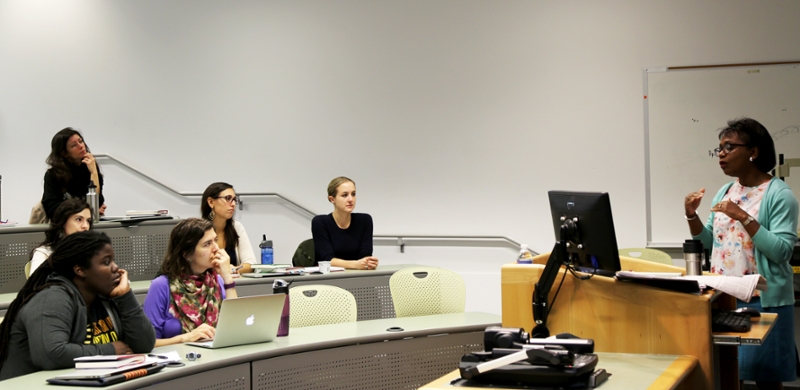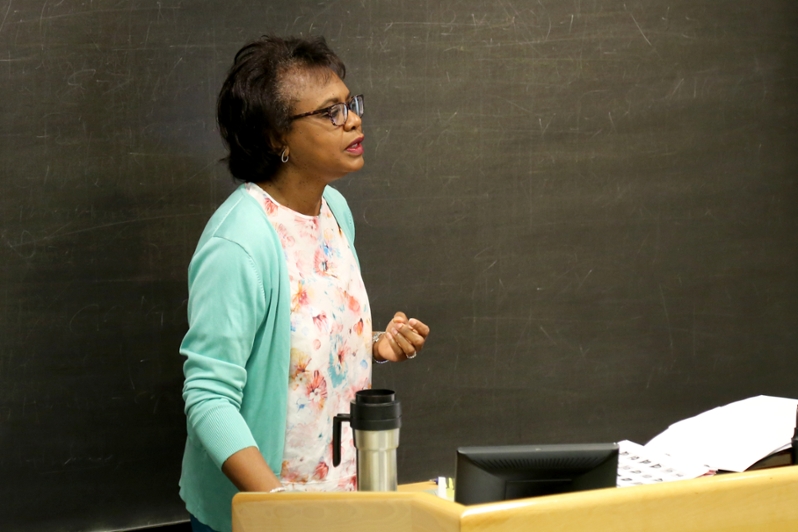
For the first time since 2006, Anita Hill is teaching a course on gender equity and law at the Heller School. The seven-week module, which she describes as, “a fast and furious look at gender issues,” focuses on gender equity in employment and housing policy through the lens of law and litigation. To design the course, Hill drew upon her many years of experience as a law professor, gender equity advocate and public intellectual.
This willingness and ability to jump nimbly across disciplines—from law to gender studies, from employment to housing policy—is a hallmark of Hill’s style as a professor and academic. It was also a key factor in her recent promotion to university professor, Brandeis University’s highest faculty honor.
She is quick to add, however, that this course also relies on the varied experience of her 35 social policy and management students. The class includes a mix of masters and doctoral students from across the spectrum of Heller’s degree programs. The students welcome this diversity of discipline and perspective in their classmates. “It’s probably one of the best classes I’ve ever taken,” says Mary Casady, MBA’16. “She does a good job of not only being a subject matter expert, but a great professor, which sometimes can be rare to find. I feel like taking a course on gender and law with Anita Hill at the Heller School is the ultimate thing you’re supposed to do when you’re a Heller student.”
The course covers gender inequities in both housing and employment. Hill’s goal is for her students “to learn how to construct policies that provide equity and fairness. I’d like for them to be able to create policies, not just read about them and tell me what’s wrong with them. I’d like them to be imaginative, and to know what the source of existing tensions are so they can create something better.”

The course started out with housing, both in the sense of affordable housing and also in terms of housing design. “We examine whether housing is designed with women in mind in their fullest capacities, or if housing is designed for two parent heterosexual families with the woman staying at home and the man being the breadwinner,” says professor Anita Hill. “We’re also looking at employment, in the fullest forms. I tell my students to consider women not just in a certain age group, but women throughout their lifespan, from when they get their first job, all the way to retirement age. We’re not just looking at women who are breaking the glass ceiling, but at women in entry-level positions.”
Hill recognizes that employment and housing policies don’t exist in isolation from other policy arenas where women face inequities. She acknowledges that sexual identity, race, gender violence, immigration status, transportation, disability, class and a host of other factors compound gender disparities. She helps students make these connections during class discussion, but acknowledges that there isn’t enough space in seven weeks to cover it all. “I hope this will give the students connections between their discipline and others,” says Hill.
The course reflects an ambitious scope, she admits, but “I’m hoping it’s just the start of an interest for the students. I get excited when I go into the classroom and I see students taking on new materials. I feel like we’re doing the right thing.” To Hill, introducing these new concepts isn’t useful just for the purpose of learning something new—she wants to provide her students with new frameworks so that they can apply a gender equity lens to the topics they’re already interested in.
Erin Robinson, MPP’16, says, “It's great to take a course which covers legal decisions and their relationship to policy. I have never taken a course focused specifically on gender before and this has been a great introduction for me. I now see gender discrimination in places where I wouldn't expect. I know that sounds like a bad thing, but as a future policy practitioner, I want to be able to recognize disparities in an effort to better serve the public.”
Why does gender matter to Anita Hill? “Because everybody has at least one,” she says. “We deal with a lot of social issues here at the Heller School and whether you are talking about health, assets, education, youth and children--anything—gender is a component that impacts every one of those areas. Gender is always one of those categories where you find disparities that suggest inequity. It’s important for our students to learn what role gender constructs play in contributing to inequality and develop ways to address it.”
